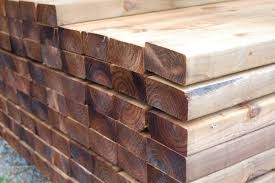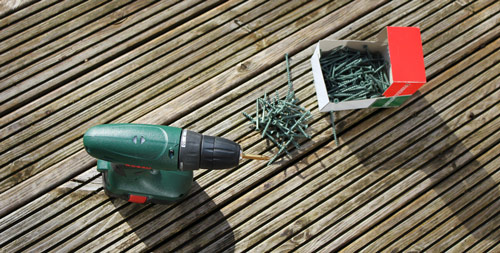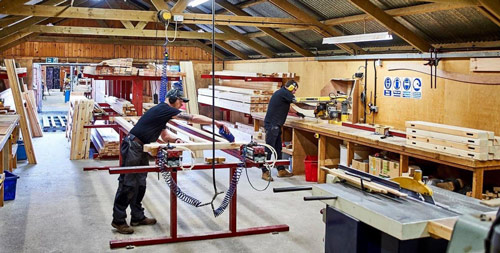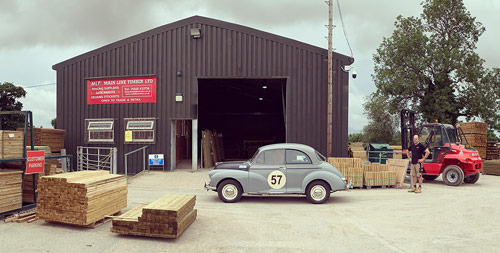What does C16 and C24 mean?

Timber grades refer and mark the quality of timber to help users choose the correct and best type of timber for the intended end use. Understanding timber grades allows the strength, moisture content, and aesthetic appeal to be some of the best guides to pick the right choice of timber.
In this article we are going to discuss the difference between C16 and C24. Why these two? There are twelve official strength grades as set by the British Standards BS 5268, but these two grades are the most used and commonly spoken about in the UK.
Timber Grading
Whether from the UK, or imported from Europe, all softwood structural timber starts its life as a coniferous tree, such as Spruce or Pine. The C before the grading originates from Coniferous and the number denotes its strength, for example, C16 = 16N/mm2 and C24 = 24N/mm2. Â
Softwood timber grading timber’s strength class can be graded by visual inspection, or machine. Visual inspection is the oldest form of grading and is still the preferred method. Machine grading is typically used for grading high volumes of timber of similar species and cross section. Below the strength grade, you will see a letter M printed which highlights the timber has been machine graded.
There are several consideration’s which affects the timber grading:
- Knots - naturally, more knots mean less strength.
- Shakes or splits along the grain of the wood.
- Slope of the grain.
- Uniform appearance.
- Woodworm holes or insect damage.
Once these considerations have been taken into account, the timber is then graded to one of four strength classes:
- C14 – This is the lowest class. The timber has lower strength and quality and often used for low or none bearing use such as framing. Â
- C16 – This class is medium to higher strength and quality. This type of timber is ideal for medium load bearing and can be used as partitioning.
- C18 – High strength with higher quality where the timber is typically used for medium to higher load bearing such as commercial decking or roof battens.
- C24 – This timber has the highest strength and quality where it is ideal for load bearing such as balconies.
Hardwoods are graded slightly differently and put into one of six strength classes - D24, D30, D40, D50, D60 and D70 (with the 'D' standing for ‘deciduous’ wood).
What is C16 Timber?
C16 is a kiln-dried softwood to achieve a moisture content of less than 20%. C16 timber can be used and is ideal for construction projects, as it offers a good amount of strength and quality and is a cheaper option to C24.
The timber itself slows for some defects, including, knots and general grain deviations affecting strength as well as sap stains and uneven surfaces having an aesthetic impact. Although it may appear to be of slightly lower quality, the timber itself is an ideal choice for portioning and joist work.
Is C16 timber suitable for outdoor use?
Although C16 timber is the preferred choice for indoor projects, if it is properly treated and sealed, it’s possible to use it successfully externally. Decking is a choice of use when using outdoors.
Is C16 load bearing?
C16 timber a cheaper option to C24, despite its defects. It is suitable for load bearing up to a certain point, such as for some domestic floor joists. It is recommended to use C16 timber for loads not exceeding 1.5 kN/m².
What is C24 Timber?
C24 is kiln-dried and planed and is the highest strength and quality of softwood timber. It is premium quality wood that is considerable for heavy load bearing or when a knot free finish is required.
C24 is more expensive than C16. This is down to its superior strength and appearance. You will often find C24 timber is grown abroad in climates that force a slower growth rate and tighter grain.
Can you use C24 outdoors?
C24 can be used outside, again, providing it is treated and sealed correctly. This is to prevent warping, rot, and damage overtime from infestation from insects and general weathering.
How much stronger is C24 than C16?
C24 timber is a lot stronger than C16 but both can be suitable for load bearing. The actual weight can depend on the size and function of the wood and end use, as a guide, see below for the differences in practice.
Strength & Properties Class |
C16Â Â |
C24Â Â |
Bending parallel to grain (N/mm2) |
5 |
8 |
Tension parallel to grain (N/mm2) |
3 |
5 |
Compression parallel to grain (N/mm2)Â Â Â |
2 |
8 |
Compression perpendicular to grain (N/mm2) |
2.2-1.7 |
2.4-1.9 |
Shear parallel to grain (N/mm2)Â Â Â |
1 |
1 |
 Modulus of elasticity mean (N/mm2) |
8800 |
10800 |
Modulus of elasticity minimum (N/mm2) |
5800 |
7200 |
Characteristic density (kg/m5) |
310 |
350 |
Average density (kg/m5) |
370 |
420 |












